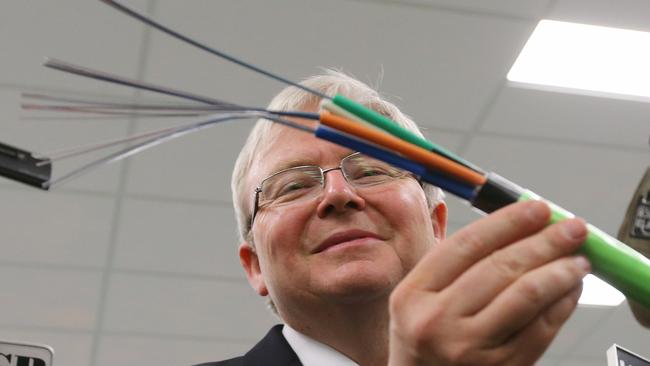NBN goes after new business and Telstra
The NBN has just come through the most extreme ‘stress test’ anyone could have been imagined and it came through spectacularly. And now customers are going to be the big winners, writes Terry McCrann.

Terry McCrann
Don't miss out on the headlines from Terry McCrann. Followed categories will be added to My News.
NBNCo has moved to both slash the cost of broadband to suburban and regional businesses and dramatically increase both the download and, importantly, upload, available speeds.
It is a move which shows precisely how the NBN can very effectively and very creatively build out and deepen both its broadband infrastructure and increase the quality of the services and products offered users.
In short and in combination, this is the ability to deliver faster broadband at scale; and deliver it cheaper. And by doing so, significantly increase the competitive dynamics at the retail provider level.
One reaction to the latest move by NBN Co is that it will directly compete with Telstra in both fixed and (5G) mobile broadband.
Duh; that is precisely the whole point – not just of this latest move but of the entire NBN project!
This is and always was, to put in place a pervasive (and cost effective) broadband network at the wholesale level; to allow a thousand flowers (OK, maybe 100 players – sorry Mao) to bloom/compete at retail where there was mostly only one before.

It is a move which is also really only possible precisely because we got the pervasive nationwide network built quickly by switching to Malcolm Turnbull’s mixed fibre-HFC-copper configuration rather than stick with Kevin Rudd’s (and Stephen Conroy’s) all-fibre fantasy.
Yes, obviously, all-fibre would be and always would have been ‘better’. But that is as useful as saying that four-lane freeways to every house in the land would be ‘better’.
Setting aside the question of cost – and despite the ludicrous claims, comparing the fantasy cost projections made for all-fibre at the start of the build back in 2010 with the 2020 reality of what the actual NBN cost and what an all-fibre one would have cost, all-fibre would have cost at least $30bn more – the even more important question is one of time.
The Turnbull NBN is done, pervasively across Australia. The Rudd all-fibre fantasy would have been at best 40-50 per cent built by now, with something like half of Australia still stuck on all-copper DSL and ADSL.
Apart from the (bleeding) obvious fact that you couldn’t role out all-fibre business-focused sub-networks off a half-copper base, you would really just be further complicating – and delaying – the core network infrastructure build if you tried.
Getting the (yes, less than perfect) core network built allows it now to be progressively upgraded to more and more fibre off a pervasive nationwide revenue base that is both already substantial and rising strongly.

Very importantly, the network build can be better designed to be state-of-the art and focused both to compete with and – just as importantly – integrate with and underwrite the 5G mobile networks that weren’t even contemplated when fixed all-fibre was embraced.
Heck, back then, when Rudd and Conroy were fantasising, we didn’t even have 4G – and indeed, we barely had the first iPhone.
To have continued to put all our eggs – and dollars – in an all-fibre fixed network that might have got fully built by around 2025 – if we were lucky, closer to 2030 in reality – would have left us in a right mess, here in 2020 where we are.
The NBN has just come through the most extreme ‘stress test’ anyone could have been imagined (and, it was so extreme, no-one did imagine it). And it came through spectacularly.
It was not only the stressiest of all stress tests – everyone working from home; but also, precisely because of that, ripe for every disgruntled user to complain and complain loudly and directly, well, online, whether sitting in their PJs at their parents’ or otherwise.
“Yet we haven’t seen it; indeed there’s been barely a whisper of complaint, beyond the usual from the said PJ-clad gigabyte geeks.
Apart that is, from young Master Kevin, still pining for The Lodge and an all-fibre fantasy future.
Originally published as NBN goes after new business and Telstra

